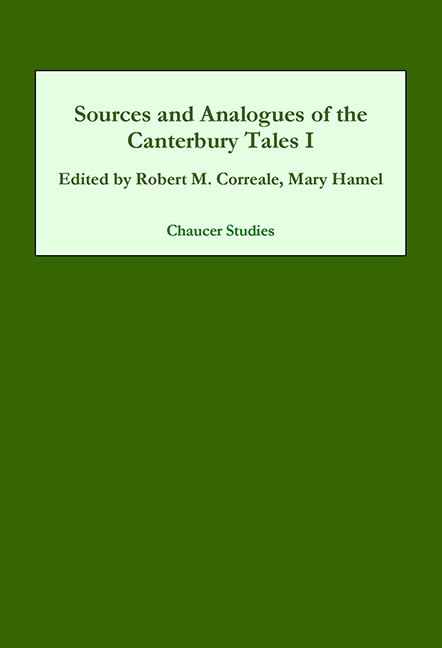Book contents
- Frontmatter
- Contents
- preface
- Acknowledgements
- The Frame
- The Reeve's Tale
- The Cook's Tale
- The Friar's Tale
- The Clerk's Tale
- The Squire's Tale
- The Franklin's Tale
- The Pardoner's Prologue and Tale
- The Tale of Melibee
- The Monk's Tale
- The Nun's Priest's Tale
- The Second Nun's Prologue and Tale
- The Parson's Tale
- Contributors and editors
- General Index
- Index of Manuscripts
The Clerk's Tale
Published online by Cambridge University Press: 25 October 2017
- Frontmatter
- Contents
- preface
- Acknowledgements
- The Frame
- The Reeve's Tale
- The Cook's Tale
- The Friar's Tale
- The Clerk's Tale
- The Squire's Tale
- The Franklin's Tale
- The Pardoner's Prologue and Tale
- The Tale of Melibee
- The Monk's Tale
- The Nun's Priest's Tale
- The Second Nun's Prologue and Tale
- The Parson's Tale
- Contributors and editors
- General Index
- Index of Manuscripts
Summary
Chaucer's Clerk's Tale is the first English rendering of the Griselda story, which by the end of the fourteenth century had also captured the imagination of many other writers and readers in Western Europe. In adapting this story for the Canterbury Tales, Chaucer was part of a broad pattern of response to its simple plot, another participant in the tale's transmission across cultures, languages, and national boundaries. J. Burke Severs established definitively that Chaucer's principal sources for the Clerk's Tale were Petrarch's Latin Historia Griseldis and Le Livre Griseldis, an anonymous French translation of Petrarch. His excellent scholarship soon made comparison of the Clerk's Tale to the Latin Historia Griseldis a standard practice in most modern criticism. In the last twenty years, however, scholars have broadened their interest to include other versions of the tale, in part because it is likely that Chaucer had some knowledge of them and in part because they can tell us about the tale's cultural value in the late Middle Ages. The tale's many redactors gave the story a variety of interpretive contexts, addressed divergent audiences, and refashioned Griselda to exemplify numerous virtues and behaviors. These competing versions can contribute to our understanding of the narrative possibilities of the material Chaucer took up and his achievement in the Clerk's Tale.
- Type
- Chapter
- Information
- Sources and Analogues of the Canterbury Tales: vol. I , pp. 101 - 168Publisher: Boydell & BrewerPrint publication year: 2002

